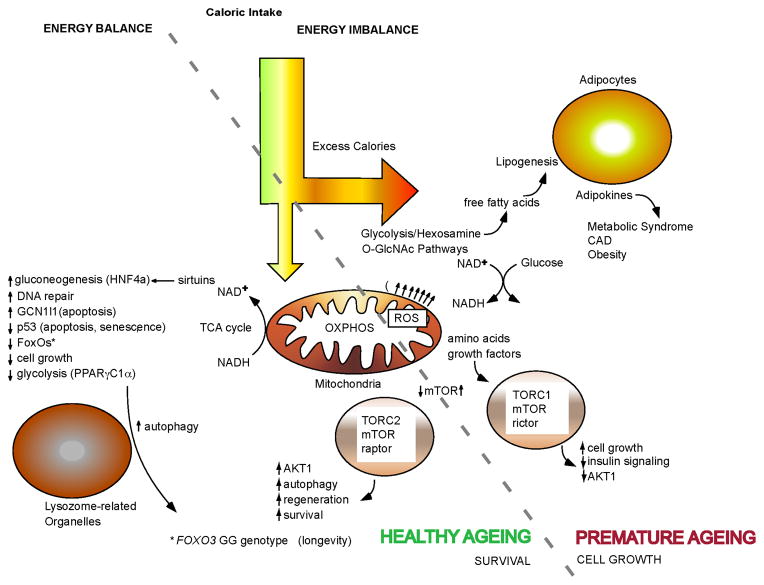Fig. 2.
Mechanisms by which FoxOs influence healthy ageing. Shown are several of the key intracellular pathways targeted by FoxO transcription factors. FoxOs are master regulators that translate environmental stimuli arising from insulin, growth factors, nutrients and oxidative stress into specific gene expression programs. The role of FoxO3 in longevity may involve upregulation of target genes involved in stress resistance, metabolism, cell cycle arrest, and apoptosis. Effective control of FoxO3 in response to environmental stimuli is likely critical to prevent ageing and age related diseases including cardiovascular disease, type 2 diabetes, cancer and neurodegenerative diseases. The diagram shows how the well-known longevity-associated intervention of caloric restriction helps to maintain the redox state of the cell by cycling calories through the mitochondria so as to restore NAD+. Caloric restriction results in activation of sirtuins, leading to activation of FoxOs, improved autophagy, amino acid recycling via inhibition of mTOR activity, and other mechanisms leading to a healthy ageing phenotype. On the other hand, excess calories, particularly from carbohydrates, increase the NADH/NAD+ ratio and leads to lipogenesis, overproduction of ROS by mitochondria, poor autophagy and activation of mTOR as a result of an excess of protein intake.
Abbreviations: AKT1, a term derived from the “Ak” mouse strain that develops spontaneous thymic lymphomas (AKT1 is also known as protein kinase B); CAD, coronary artery disease; HNF4a, hepatocyte nuclear factor 4α; GCN1l1, general control of amino acid synthesis 1-like 1; mTOR, mechanistic target of rapamycin; O-GlcNAc, O-linked N-acetylglucosamine’ OXPHOS, oxidative phosphorylation; PPARγC1α, peroxisome proliferator activated receptor γ coactivator 1α; TCA, tricarboxylic acid; TORC1, mTOR complex 1; TORC2, mTOR complex 2.

